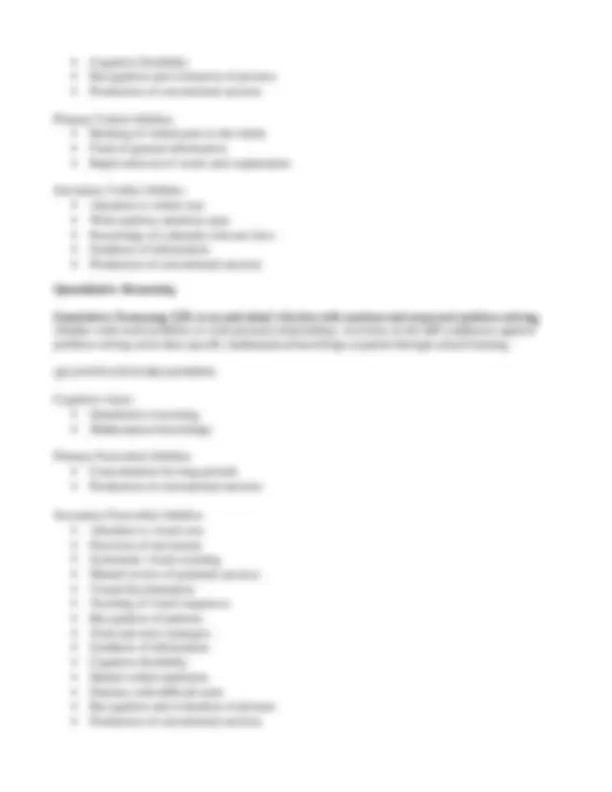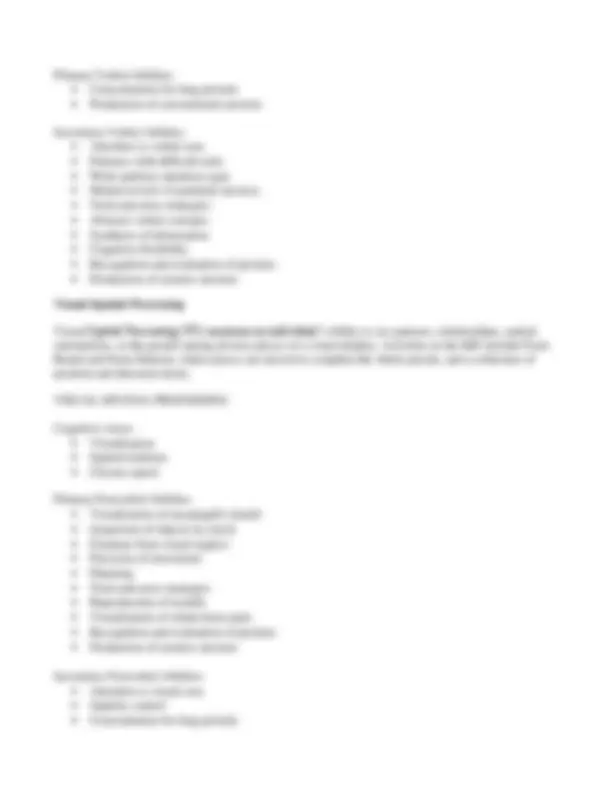





Study with the several resources on Docsity

Earn points by helping other students or get them with a premium plan


Prepare for your exams
Study with the several resources on Docsity

Earn points to download
Earn points by helping other students or get them with a premium plan
Community
Ask the community for help and clear up your study doubts
Discover the best universities in your country according to Docsity users
Free resources
Download our free guides on studying techniques, anxiety management strategies, and thesis advice from Docsity tutors
The Full Scale IQ (FSIQ) is derived from the sum of all the tasks in the SB5. It covers both the Verbal and Nonverbal domains of cognitive ability in a ...
Typology: Study notes
1 / 7

This page cannot be seen from the preview
Don't miss anything!




Full Scale IQ
The Full Scale IQ (FSIQ) is derived from the sum of all the tasks in the SB5. It covers both the Verbal and Nonverbal domains of cognitive ability in a balanced design and taps the five underlying factor index scales of the SB5. The FSIQ provides a global summary of the examinee's current general level of intellectual functioning as measured by the SB5. The FSIQ is considered a reliable measure of g , or the general ability to reason, solve problems, and adapt to the cognitive demands of the environment. The FSIQ measures more than acquired knowledge from schooling; it also measures the sum of five major facets of intelligence: reasoning, stored information, memory, visualization, and the ability to solve novel problems. In research, global scores such as the FSIQ have been found to be the most effective predictors of long-term educational attainment, school-based achievement, and vocational advancement. When Nonverbal IQ (NVIQ) and Verbal IQ (VIQ) scores are not significantly different, the FSIQ typically will be the most prominent score in the SB5 interpretation.
Nonverbal IQ
The SB5 Nonverbal IQ is based on the nonverbal subtests of the five factor index scales. It measures skills in solving abstract, picture-oriented problems; recalling facts and figures; solving quantitative problems shown in picture form; assembling designs; and recalling tapping sequences. The NVIQ measures the examinee's general ability to reason, solve problems, visualize, and recall information presented in pictorial, figural, and symbolic form, as opposed to information presented in the form of words and sentences (printed or spoken). The NVIQ does require a small degree of auditory skill for understanding brief examiner-spoken directions.
Verbal IQ
The SB5 Verbal IQ provides a composite of all the cognitive skills required to solve the items in the five verbal subtests. The VIQ measures general ability to reason, solve problems, visualize, and recall important information presented in words and sentences (printed or spoken). Additionally, the VIQ reflects the examinee’s ability to explain verbal responses clearly, present rationales for response choices, create stories, and explain spatial directions. The VIQ subtests require the examinee to understand the examiner’s spoken directions and then clearly vocalize responses to questions. General verbal ability, measured by VIQ, is one of the most powerful predictors of academic success in Western cultures, because of the heavy reliance on reading and writing in formal school programs.
Abbreviated Battery IQ
The Abbreviated Battery IQ (ABIQ) is based on two routing subtests—one nonverbal (Object Series/Matrices) and one verbal (Vocabulary). The ABIQ provides a quick estimate of two major cognitive factors: fluid reasoning and crystallized ability. Object Series/Matrices requires the examinee to identify patterns or series of objects and pictures, and to solve novel pictorial problems presented in the matrix-analogy format. The Vocabulary subtest requires examinees to use their verbal knowledge, acquired and stored in memory from years of exposure to printed and spoken English, in school, at home, or at work. The ABIQ can be used for assessments such as neuropsychological examinations, in which a battery of tests supplements the SB5, or for quick yet reliable assessments to verify the general cognitive status of an individual. The ABIQ measures the areas of Nonverbal Fluid Reasoning and Verbal Knowledge and includes two of the most important abilities predictive of academic and
vocational advancement.
Fluid Reasoning
Fluid Reasoning (FR) is the ability to solve verbal and nonverbal problems using inductive or deductive reasoning. Classic activities such as Matrices require the individual to determine the underlying rules or relationships among pieces of information (such as visual objects) that are novel to him or her. The ability to reason inductively (as in the Matrices or Verbal Analogies activities) requires the examinee to reason from the part to the whole, from the specific to the general, or from the individual instance to the universal principle. In deductive reasoning activities, the examinee is given general information and is required to infer a conclusion, implication, or specific example. In the SB5, the Early Reasoning activity items require the examinee to inspect pictures depicting human activities and deduce the underlying problem or situation by telling a story.
FLUID REASONING
Cognitive Areas Inductive and deductive reasoning General sequential reasoning Oral production and visual memory fluency
Primary Nonverbal Abilities Attention to visual cues Concentration for long periods Visualization of abstract stimuli Recognition of patterns Synthesis of information Mental verbal mediation Search strategies Tracking of visual sequences Visual discrimination Visual scanning Mental review of potential answers
Secondary Nonverbal Abilities Visualization of meaningful stimuli Inspection of objects by touch Freedom from visual neglect Toleration of ambiguity Patience with difficult tasks Trial-and-error strategies Cognitive flexibility Recognition and evaluation of pictures
Primary Verbal Abilities Rapid retrieval of words and explanations Attention to verbal cues
Cognitive flexibility Recognition and evaluation of pictures Production of conventional answers
Primary Verbal Abilities Relating of verbal parts to the whole Fund of general information Rapid retrieval of words and explanations
Secondary Verbal Abilities Attention to verbal cues Wide auditory attention span Knowledge of culturally relevant facts Synthesis of information Production of conventional answers
Quantitative Reasoning
Quantitative Reasoning (QR) is an individual’s facility with numbers and numerical problem solving, whether with word problems or with pictured relationships. Activities in the SB5 emphasize applied problem solving more than specific mathematical knowledge acquired through school learning.
QUANTITATIVE REASONING
Cognitive Areas Quantitative reasoning Mathematical knowledge
Primary Nonverbal Abilities Concentration for long periods Production of conventional answers
Secondary Nonverbal Abilities Attention to visual cues Precision of movement Systematic visual scanning Mental review of potential answers Visual discrimination Tracking of visual sequences Recognition of patterns Trial-and-error strategies Synthesis of information Cognitive flexibility Mental verbal mediation Patience with difficult tasks Recognition and evaluation of pictures Production of conventional answers
Primary Verbal Abilities Concentration for long periods Production of conventional answers
Secondary Verbal Abilities Attention to verbal cues Patience with difficult tasks Wide auditory attention span Mental review of potential answers Trial-and-error strategies Abstract verbal concepts Synthesis of information Cognitive flexibility Recognition and evaluation of pictures Production of creative answers
Visual-Spatial Processing
Visual-Spatial Processing (VS) measures an individual’s ability to see patterns, relationships, spatial orientations, or the gestalt among diverse pieces of a visual display. Activities in the SB5 include Form Board and Form Patterns, where pieces are moved to complete the whole puzzle, and a collection of position and direction items.
VISUAL-SPATIAL PROCESSING
Cognitive Areas Visualization Spatial relations Closure speed
Primary Nonverbal Abilities Visualization of meaningful stimuli Inspection of objects by touch Freedom from visual neglect Precision of movement Planning Trial-and-error strategies Reproduction of models Visualization of whole from parts Recognition and evaluation of pictures Production of creative answers
Secondary Nonverbal Abilities Attention to visual cues Impulse control Concentration for long periods
Retention span
Secondary Nonverbal Abilities Attention to visual cues Concentration for long periods Freedom from visual neglect Visual discrimination Mental verbal mediation
Primary Verbal Abilities Impulse control Freedom from distractibility Patience with difficult tasks Wide auditory attention span Retention span
Secondary Verbal Abilities Attention to verbal cues Concentration for long periods Relating of verbal parts to the whole Rapid retrieval of words and explanations